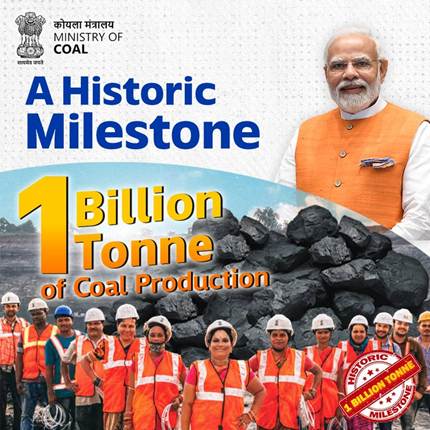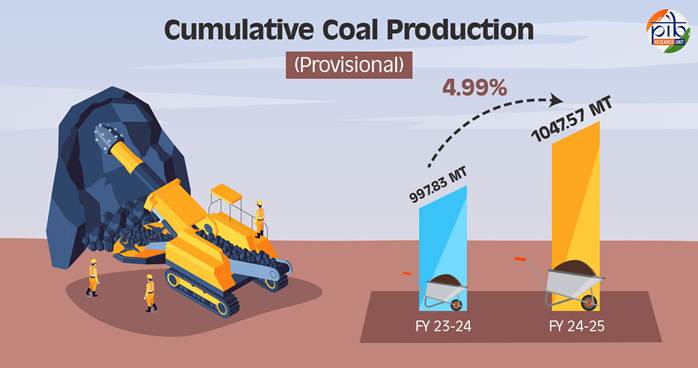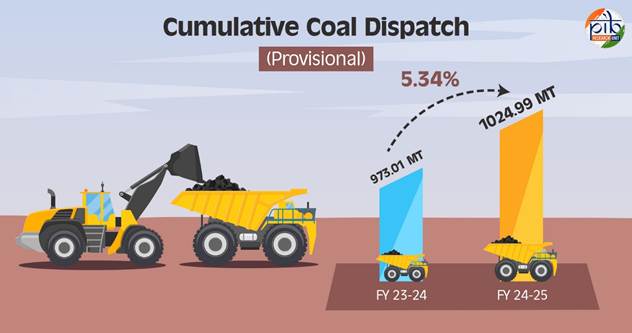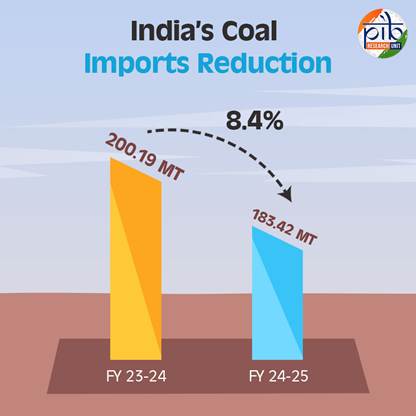Ministry of Coal
India’s Coal Boom
Production Surpasses One Billion Tonnes
प्रविष्टि तिथि:
04 APR 2025 3:58PM by PIB Delhi
|
Key takeaways
- India has achieved a historic milestone by surpassing one billion tonnes of coal production in FY 2024-25, with a 4.99% growth in output compared to the previous year.
- The country's coal imports decreased by 8.4%, leading to substantial foreign exchange savings and a reduction in import dependency.
- The coal sector remains a crucial contributor to India’s energy mix, powering over 74% of the country’s electricity and sustaining key industries like steel and cement.
- A focus on coal gasification is positioning India to leverage syngas for producing methanol, fertilizers, and synthetic natural gas, promoting environmental sustainability.
|
Introduction
India achieved a historic milestone by surpassing one billion tonnes (BT) of coal production on 20 March 2025, in FY 2024-25—11 days ahead of last year’s 997.83 million tonnes (MT). With the fifth-largest coal reserves and as the second-largest consumer, coal remains crucial, contributing 55% to the national energy mix and fuelling over 74% of total power generation. The coal sector’s success is attributed to the tireless efforts of Coal Public Sector Undertakings (PSUs), private players, and the dedicated workforce of around 5 lakh mine workers across more than 350 coal mines. These coal miners, who have defied numerous challenges with unmatched dedication, have played a pivotal role in achieving this historic milestone.

Growth in Coal Production and Dispatch

India’s coal production has reached 1047.57 MT (Provisional) in FY 2024-25, compared to 997.83 MT in FY 2023-24, marking a 4.99% growth. Production from Commercial & Captive, and other entities also saw a remarkable surge, reaching 197.50 MT (Provisional)—a 28.11% increase from 154.16 MT recorded in the previous year.
|
Coal production refers to the extraction of coal from mines.
|
Coal dispatch has also crossed the One BT milestone, with total dispatch reaching 1024.99 MT (Provisional) in FY 2024-25, up 5.34% from 973.01 MT in FY 2023-24. Dispatch from Commercial, Captive, and other entities witnessed an even more significant rise, reaching 196.83 MT (Provisional)—a 31.39% increase compared to 149.81 MT in the previous year.

|
Coal dispatch refers to the process of transporting and distributing that coal to various consumers, including power plants and industrial facilities.
|
Indian coal sector achieves notable reduction in imports

Coal imports fell 8.4% to 183.42 MT in April-December 2024 from 200.19 MT in the same period of FY 2023-24, saving $5.43 billion (₹42,315.7 crore) in foreign exchange. The Non-Regulated Sector saw a sharper decline of 12.01%, while imports for blending by thermal power plants dropped 29.8%, despite a 3.53% rise in coal-based power generation.
Government initiatives like Commercial Coal Mining and Mission Coking Coal boosted domestic coal output by 6.11% during this period, reducing import dependence.
Coal remains crucial for power, steel, and cement industries, but shortages in coking and high-grade thermal coal make imports necessary. The Ministry of Coal is strengthening domestic production to enhance energy security and advance Viksit Bharat, ensuring a self-reliant, sustainable energy framework for long-term growth.
Economic significance of the coal sector
Coal is vital to India’s energy needs, supplying over half of the country’s power. Despite renewable energy growth, coal-based thermal power will remain essential, with its share projected at 55% by 2030 and 27% by 2047.
Key contributions:
- Railways & revenue: Coal stands as the single largest contributor to railway freight, with an average share of nearly 49% of total freight income amounting to Rs. 82,275 Crore in the fiscal year 2022-23 alone. This revenue contribution has surpassed 33% of total railway earnings, showcasing the sector's substantial influence on India's transportation network.
- Government earnings: The coal sector contributes over Rs. 70,000 Crore annually to the central and state governments through royalties, GST, and other levies. These funds play a crucial role in fostering socio-economic development and infrastructure enhancement in coal-producing regions. Coal production generates substantial revenue for both Central and State Governments, with royalty collections reaching Rs. 23,184.86 Crore in the fiscal year 2022-23.
- Employment: The sector provides jobs to over 239,000 workers in Coal India Ltd and thousands more in contractual and transport roles.
- Economic growth Substantial investments in capital expenditure, averaging Rs. 18,255 Crore annually over the past five years, have facilitated infrastructure development and resource optimization within coal sector PSUs.
Coal gasification initiative
The Government has undertaken the following coal gasification initiatives:
- Financial incentive: On 24th January 2024, the Government approved ₹8,500 crore for promoting coal/lignite gasification projects for PSUs and the private sector.
- Investment by CIL: Coal India Limited (CIL) has been approved to invest in joint ventures with BHEL and GAIL for coal gasification projects.
- New sub-sector: In 2022, "Production of Syngas leading to coal gasification" was added under the NRS linkage auctions policy. Auctions under this sector have a floor price at the regulated sector's notified price for projects commissioning within next seven years.
- Revenue share rebate: A 50% rebate in revenue share for coal used in gasification has been introduced in commercial coal block auctions, provided at least 10% of the total coal production is used for gasification.
|
Coal gasification converts coal into syngas, which can be used for producing methanol, ammonium nitrate, Synthetic Natural Gas (SNG), and fertilisers. This technology promotes environmental sustainability in line with the vision of a developed India by 2047.
|
Safety audit of coal mines
As per the Ministry of Coal’s "Safety Health Management System Audit" guidelines (December 2023), safety audits are conducted annually. On 17th December 2024, the "National Coal Mine Safety Report Portal" was launched, incorporating a safety audit module for audit report submissions.
Key safety measures:
- Regulatory updates: Directorate General of Mines Safety revamped the Coal Mines Regulations 1957 into The Coal Mines Regulations 2017, addressing modernisation, mechanisation, emergency response, and evacuation planning.
- Advanced mining technologies:
- Blast-free mining: Introduction of Blast-free mining technologies, such as Continuous Miner, Powered Support Longwall (PSLW) in UG mines, Surface Miner, Eccentric/Vertical Ripper in Opencast (OC) mines and Hybrid High Wall mining to extract coal seams that are not techno-economically viable through traditional opencast mining method.
- Real-time monitoring: Real-time monitoring of UG mine environment by Environmental Telemonitoring System (ETMS) and Gas Chromatographs are used for quick and accurate mine air sampling.
- Strata control: Mechanised roof bolting arrangement i.e. Universal Drilling Machine (UDM), QUAD and Twin Bolter systems, along with resin capsules and advanced instrumentation for strata monitoring.
- Dust control: Dust suppression systems like truck-mounted Fog Canons and Sprinkler cum-mist sprays to reduce dust.
- Training: Simulator-based training for Heavy Earth Moving Machinery (HEMM) operators and Virtual Reality (VR) training programs.
- Monitoring: Modern technologies like Total Stations, 3D Terrestrial Laser Scanning (TLS), and Slope Stability Radars for monitoring slope and overburden (OB) dump stability. GPS-based Operator Independent Truck Dispatch System (OITDS), Geo-fencing in large OC to track HEMM movements.
Environmental & worker welfare initiatives:
- Environmental protection: Environmental Impact Assessment studies are conducted before project approval, and ongoing environmental monitoring is ensured.
- Worker welfare: Mines Rules, 1955 (under Mines Act, 1952) ensures health checks, first aid, shelters, canteens, and welfare officers. Additional initiatives include housing, clean drinking water, scholarships, financial assistance, healthcare, and compassionate employment.
- Skill development: Structured vocational training, simulator-based training, specialised job training in drilling, blasting, fire safety, and safety workshops for Workmen Inspectors and Safety Committees.
Conclusion
The coal sector's continued growth and resilience are vital to India’s energy strategy, economic development, and long-term sustainability. The remarkable achievements in production, dispatch, and coal gasification initiatives highlight the sector's evolving role in meeting the nation's energy demands. Through constant advancements in safety, environmental protection, and workforce welfare, the coal industry is setting a strong foundation for future progress. The government's initiatives, alongside the dedication of the workforce, ensure that the coal sector will remain a cornerstone of India's path toward becoming a self-reliant and developed nation by 2047.
References:
Kindly find the pdf file
*****
Santosh Kumar | Sarla Meena | Anchal Patiyal
(रिलीज़ आईडी: 2118788)
आगंतुक पटल : 13540